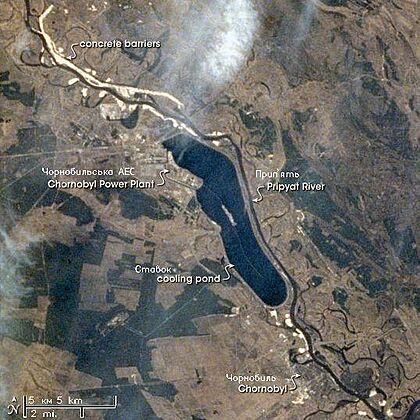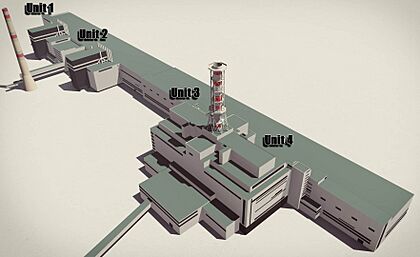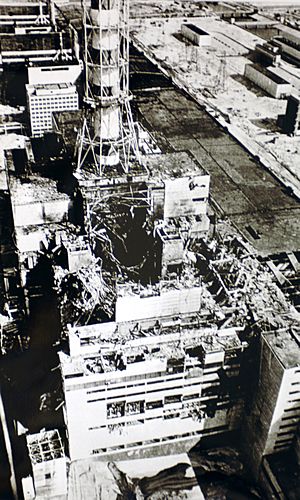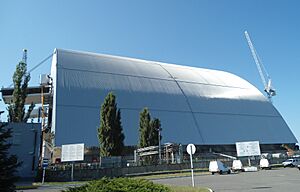Chernobyl Nuclear Power Plant facts for kids
Quick facts for kids Chernobyl Nuclear Power Plant |
|
|---|---|
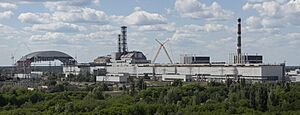
A view of the plant in 2013. From left to right: the New Safe Confinement being built, and reactors 4, 3, 2, and 1.
|
|
| Country | Ukraine |
| Location | near Pripyat, Kyiv Oblast |
| Coordinates | 51°23′21″N 30°05′58″E / 51.38917°N 30.09944°E |
| Status | Being taken apart (decommissioning) since 2015 |
| Construction began | 15 August 1972 |
| Commission date | 26 September 1977 |
| Decommission date | 1986 (Unit 4) 1991 (Unit 2) 1996 (Unit 1) 2000 (Unit 3) |
The Chernobyl Nuclear Power Plant is a famous nuclear power plant in northern Ukraine that is now being shut down. It is located near the abandoned city of Pripyat, about 100 kilometres (62 mi) north of Kyiv, Ukraine's capital.
The plant is known worldwide for the Chernobyl disaster, a major accident that happened on April 26, 1986. During a safety test, one of the reactors, Reactor No. 4, exploded. This accident released a large amount of harmful radioactive material into the air, causing the worst nuclear disaster in history.
After the disaster, the other three reactors at the plant continued to operate for some time. The last working reactor was shut down in 2000. Today, the plant is in a long process called decommissioning, which means it is being carefully taken apart and made safe. This process is expected to last until at least 2065.
Contents
Building the Power Plant
Construction of the Chernobyl Nuclear Power Plant began in 1972 when Ukraine was part of the Soviet Union. It was a very large and important project. A new city, Pripyat, was built nearby to provide homes for the thousands of workers and their families.
The plant was designed to have four powerful nuclear reactors of a type known as RBMK-1000. Together, these reactors produced about 10% of all the electricity used in Ukraine at the time.
- Reactor No. 1 started operating in 1977.
- Reactor No. 2 followed in 1978.
- Reactor No. 3 was completed in 1981.
- Reactor No. 4 began producing power in 1983.
Two more reactors, No. 5 and 6, were being built when the disaster at Reactor No. 4 occurred. After the accident, construction on these new reactors was stopped and never finished.
How the Plant Worked
Each of the four reactors at Chernobyl was housed in a large building. Inside, the reactor would heat water to create a huge amount of steam. This high-pressure steam was then used to spin large machines called turbines.
The spinning turbines were connected to generators, which produced electricity. This is similar to how most power plants work, but Chernobyl used the power of nuclear reactions to create heat. The electricity was then sent out to homes and businesses through the country's power grid.
The plant used an old computer system from the 1960s called SKALA to monitor the reactors. This system was very slow by today's standards. It could only show information to the operators and could not control the reactor on its own.
Accidents at Chernobyl
The 1986 disaster was the most famous accident at the plant, but there were other serious incidents as well.
1982 Meltdown in Reactor No. 1
On September 9, 1982, a cooling valve in Reactor No. 1 failed to open after maintenance. This caused some of the uranium fuel to overheat and break apart. This was a partial nuclear meltdown.
Radioactive steam was released from the plant's ventilation stack. The accident was not made public at the time. The reactor was repaired and put back into operation after eight months.
1986 Disaster in Reactor No. 4
The worst accident in the history of nuclear power happened on April 26, 1986. Workers at Reactor No. 4 were running a safety test to see if the plant could still operate safely during a power outage.
Due to a combination of design flaws in the reactor and mistakes made by the operators, the reactor went out of control. This led to a massive explosion that destroyed the reactor and its building. The fire that followed burned for days, releasing a huge cloud of radioactive material that spread across Europe.
The disaster had a major impact on the environment and the health of many people. The nearby city of Pripyat was evacuated and remains an empty ghost town today. The area around the plant is now known as the Chernobyl Exclusion Zone.
1991 Fire in Reactor No. 2
On October 11, 1991, a fire started in the turbine hall of Reactor No. 2. A faulty switch caused a power surge that set some electrical wires on fire. The fire caused part of the roof to collapse.
No one was hurt, and the reactor itself was not damaged. However, after this incident, officials decided it was best to shut down Reactor No. 2 for good.
Recent Events at the Plant
In 2022, Russian soldiers took control of the power plant for about a month. This activity stirred up radioactive dust in the area, causing radiation levels to rise for a short time. The soldiers later returned control of the plant to the Ukrainian workers.
In February 2025, the large steel building covering Reactor No. 4 was damaged in a drone attack. However, international experts from the IAEA reported that radiation levels at the site remained normal.
Shutting Down and Cleaning Up
Even after the disaster at Reactor No. 4, the other three reactors at Chernobyl kept working for many years. International pressure led to their eventual closure.
- Reactor No. 2 was shut down after the fire in 1991.
- Reactor No. 1 was shut down in 1996.
- Reactor No. 3 was the last to stop, shutting down on December 15, 2000.
Today, the entire plant is being decommissioned. This is a long and difficult process of safely taking the plant apart and cleaning up the remaining radioactive material.
The New Safe Confinement
Right after the 1986 accident, a huge concrete and steel cover called the "sarcophagus" was quickly built over the destroyed Reactor No. 4. This was done to stop more radiation from escaping. However, it was built in a hurry and was not meant to last forever.
To create a permanent solution, a much larger and safer structure was built. It is called the New Safe Confinement. This is a giant steel arch, taller than the Statue of Liberty, that was built nearby and then slid over the old sarcophagus.
The New Safe Confinement was finished in 2017. It is designed to keep the site safe for at least 100 years. Inside, robotic cranes will begin to carefully take apart the old sarcophagus and the remains of the reactor.
A special facility was also built to safely store the used nuclear fuel from the other reactors for the next 100 years. The cleanup of Chernobyl is a massive international effort that will continue for many decades.
Images for kids
See also
 In Spanish: Central nuclear de Chernóbil para niños
In Spanish: Central nuclear de Chernóbil para niños
- List of Chernobyl-related articles
- List of nuclear reactors


